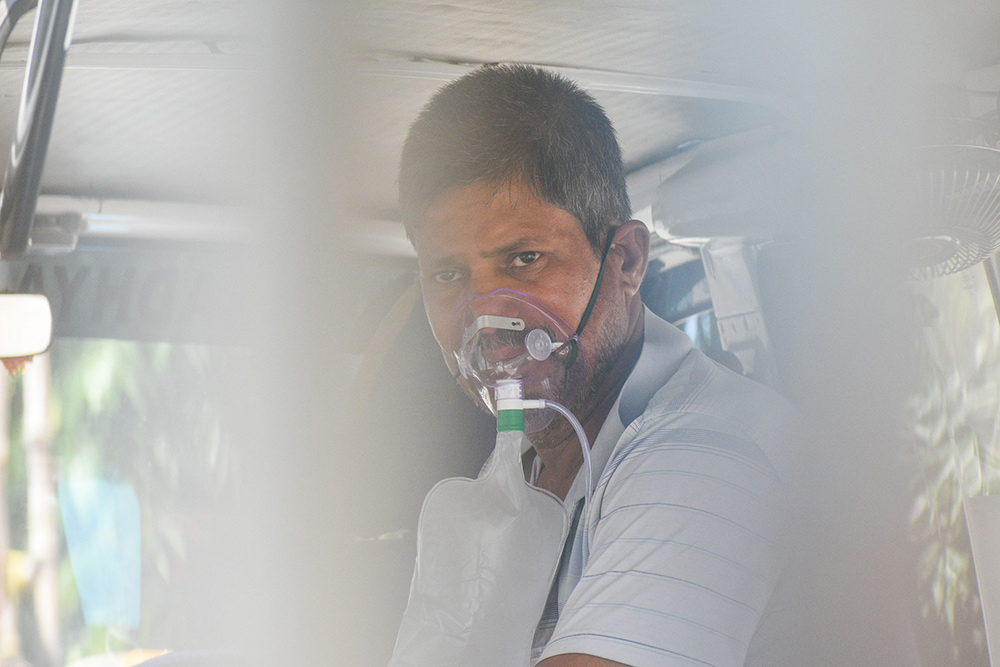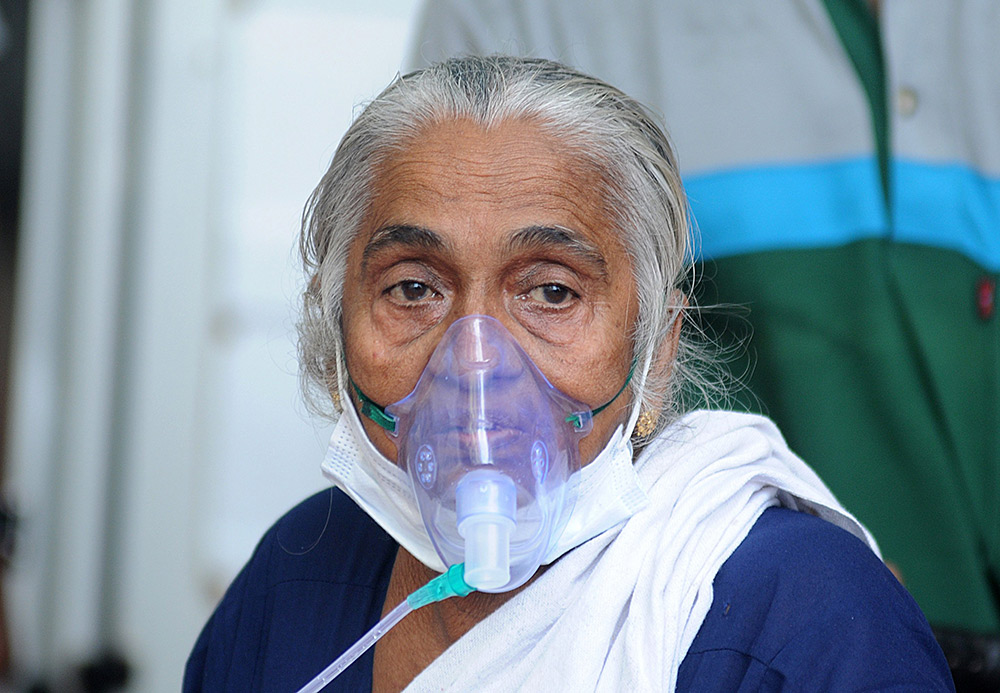印度从来没有缺过氧气,为何举国陷入“窒息”?

RK·西姆塔尼医生总是面带微笑,作为新德里巴特拉医院的肠胃科负责人,他在新冠疫情期间一直奋战在抗疫一线,并赢得了拼命三郎的美誉。
当地媒体称,他在今年春天感染上了新冠病毒,并作为患者住进了自己工作的医院。5月1日,西姆塔尼的名字出现在了12名死亡病患的清单上,享年62岁。死亡原因在于医院缺氧1小时20分钟,而此时印度猛烈的第二波新冠疫情进一步加剧了这种珍贵气体的供应短缺问题。
今年3月下旬,新冠肺炎感染病例的激增,以及后续对氧气补充的需求让印度的医疗网络猝不及防。印度曾经认为最严峻的疫情已经过去。然而在过去两周内,医用氧气的日常需求激增至疫情前水平的12倍,让巴特拉这样的医院难以应对如潮水般呼吸困难的病患。
消费者和媒体报告的小道消息称,造成氧气短缺的不仅仅是迫切的需求,恐慌导致人们以平时三倍的价格从黑市购买氧气瓶和氧气浓缩机这类设备,哪怕这些并非是买家的急需用品。
明显的短缺导致印度民众开始在社交媒体乞求氧气,并酿成了西姆塔尼遭遇的这类新冠病患死于氧气匮乏的悲剧。
实际上,印度一直以来就没有缺过氧气。然而在第二波疫情到来时,氧气被用于工业而不是医疗用途。
通常来讲,印度每天生产9000吨的液态氧。其中绝大部分用于工业,例如钢铁行业,仅有10%到15%流向医疗行业。
在印度第二波疫情(依然在持续)的峰值期间,新冠病患需要9000吨至1.1万吨的氧气。印度有能力满足这个需求,但这需要印度工业让渡出90%的氧气供应。
实现这一点需要数周的时间,以及政府的干预。

全国性氧气危机的转折点出现在4月下旬。当时,联邦政府禁止将液态氧用于工业用途,除非有极特殊情况。
印度的内政大臣阿贾伊·巴拉在写给州政府的信中提到,该禁令“将有助于增加医疗氧气的供应。”该信发布于《今日印度》杂志(India Today)。
印度最大的氧气生产商可以划分为两个阵营:工业气体专业生产商,例如INOX Air Products、林德、普莱克斯;以及印度巨头,比如塔塔钢铁和JSW Steel公司,这些印度企业旗下都拥有为制造业供应氧气的工厂。
JSW Steel的联席董事总经理、印度工业联合会的氧气供应任务组负责人塞沙基里·拉奥说,自政府下达命令之后,那些通常用于工业的氧气满足了约80%的医用氧气需求。其余用量则通过医院制氧厂、向医院供应氧气瓶的小型制氧厂以及进口来满足。JSW Steel是印度最大的钢铁生产公司和氧气消耗者。
钢铁公司的耗氧量要比它们常规的产氧量大。在过去三周中,它们将氧气产能提升了172%,达到了每天4100公吨的供应量,接近印度全国需求的一半。
印度最大的私营公司、商业巨头信实工业也在生产氧气,产量约每天1000公吨。
液态氧需求较小的消费品巨头印度烟草公司已经在通过其位于泰伦加纳邦的纸板部门向附近的医院提供医用氧气。
印度烟草的董事长桑吉夫·普里说:“当前的健康危机确实令人感到担忧,而且需要社会各个部门齐心协力,共同应对挑战。”
印度首要氧气制造商 INOX Air Products称,自己已经将日产能提升至2700吨,而疫情前日均产量只有400吨。
INOX Air Products的董事西达尔斯·贾因说:“与去年相比,公司气罐车的行驶里程增长了三倍……气罐车的填装次数也增长了三倍。”
印度政府当前经营着74家国营氧气厂,而且政府计划将这个数字增至1594家,这意味着如果需求在未来再次激增,印度将减少对工业企业氧气生产的依赖。
此外,印度政府称其已经进口了5800公吨氧气,并计划一共进口5万公吨,但并未给出具体的时间表。
尽管需求的激增让印度感到震惊,但印度如今生产的氧气已经足以满足其新冠疫情危机的需求,其截至5月9日的氧气产能达到了9524吨/天。
拉奥说:“供需问题已经成为过去时。”

批评家称,印度政府正在努力解决自己造成的问题。
印度公共卫生基金会的会长K·斯里纳特·雷迪认为,印度各地的政府官员在印度2020年的第一波疫情之后过于迅速地放松了对医用氧气的重视。他说:“德里的大型医院建立了自营的氧气生产厂,但政府却没有。第二波疫情让一些缺乏准备的地方政府猝不及防。”
雷迪指出,联邦政府也有责任,因为它认为疫情已经得到控制,并未针对第二波疫情做准备。他承认,基本上没有人会预料到第二波疫情会如此之凶猛。即便政府有所准备,氧气依然可能会供不应求。他还指出,短缺“本不应该有那么大的缺口,而且持续那么长的时间。”
政府将所有氧气转移至医用的举措并未彻底解决氧气短缺状况。物流乱象问题依然未得到解决,它不仅破坏了氧气供应链,也让德里、印度南部和印度西部果阿邦等地区的病患难以获得所需的氧气。
印度的主要氧气生产中心位于该国的东部地区,这里分布着不少用氧大户工业,例如钢铁。通常将氧气从这些地区运到印度北部、西部和南部地区的人口中心需要3天至12天的时间,具体用时取决于目的地的具体位置。
另一种工具的短缺让这种长途跋涉更加难以开展,那就是维持液态氧在零下183摄氏度低温所需的专用气罐车。
贸易团体印度工业联合会即将上任的会长TV·纳伦德兰将短缺称之为颇具挑战的瓶颈,但也表示行业和政府正在努力解决这个问题。
通过改装此前用于运输氮气和氩气的气罐车,INOX已经将其罐装车车队规模从270辆增至380辆。

林德印度公司的董事总经理阿比吉特·班纳吉称,其公司开始从海外租赁标准化集装箱。这些通常用来存放液体、气体和粉末的集装箱可以放到卡车上,用于运输氧气或长期储存。班纳吉称,租赁费由塔塔钢铁和印度烟草公司买单。
林德印度公司还建立了铁路系统,与国营企业印度集装箱公司和印度铁路合作,从印度东部向德里运送医用氧气。
为了缩短气罐车通常的往返时间——也就是驾驶满载的氧气罐前往当地配送设施,然后空车回到生产场地——政府已经开始通过军机和铁路来运输氧气罐装车。(受火灾风险限制,飞机无法搭载满载气体的气罐车。)加速返程将有效缩短整体运输时间,通过火车至少能够让其减半,通过飞机则可以节省高达90%的时间。
政府还调用了《国家灾害管理法》,这样装有氧气的气罐车在国家高速路上能够享受与救护车同样的优先行驶权。政府部门正在通过数字手段跟踪罐装车的路线,以预防司机不按计划停车,或偏离最短路线。
PCI Gases的董事总经理阿斯特·甘戈帕德哈伊称:“政府通过调动印度空军和铁路来缩短氧气从生产厂到缺氧地区的运输时间。政府还帮助通过空运和海运,从亚洲和中东国家进口液态氧。所有这些举措对缓解供应短缺问题做出了巨大贡献。”
甘戈帕德哈伊称,工业用氧的分流亦有其代价。它放缓了某些医疗设备和制氧设备部件的生产进程。然而,他敦促政府进一步加速供应,以防止第三波疫情侵袭印度。
雷迪抱有同样的想法。
“有一句谚语:‘抱最好的希望,做最坏的打算。’我们得这样做。”(财富中文网)
译者:冯丰
审校:夏林
RK·西姆塔尼医生总是面带微笑,作为新德里巴特拉医院的肠胃科负责人,他在新冠疫情期间一直奋战在抗疫一线,并赢得了拼命三郎的美誉。
当地媒体称,他在今年春天感染上了新冠病毒,并作为患者住进了自己工作的医院。5月1日,西姆塔尼的名字出现在了12名死亡病患的清单上,享年62岁。死亡原因在于医院缺氧1小时20分钟,而此时印度猛烈的第二波新冠疫情进一步加剧了这种珍贵气体的供应短缺问题。
今年3月下旬,新冠肺炎感染病例的激增,以及后续对氧气补充的需求让印度的医疗网络猝不及防。印度曾经认为最严峻的疫情已经过去。然而在过去两周内,医用氧气的日常需求激增至疫情前水平的12倍,让巴特拉这样的医院难以应对如潮水般呼吸困难的病患。
消费者和媒体报告的小道消息称,造成氧气短缺的不仅仅是迫切的需求,恐慌导致人们以平时三倍的价格从黑市购买氧气瓶和氧气浓缩机这类设备,哪怕这些并非是买家的急需用品。
明显的短缺导致印度民众开始在社交媒体乞求氧气,并酿成了西姆塔尼遭遇的这类新冠病患死于氧气匮乏的悲剧。
实际上,印度一直以来就没有缺过氧气。然而在第二波疫情到来时,氧气被用于工业而不是医疗用途。
通常来讲,印度每天生产9000吨的液态氧。其中绝大部分用于工业,例如钢铁行业,仅有10%到15%流向医疗行业。
在印度第二波疫情(依然在持续)的峰值期间,新冠病患需要9000吨至1.1万吨的氧气。印度有能力满足这个需求,但这需要印度工业让渡出90%的氧气供应。
实现这一点需要数周的时间,以及政府的干预。
全国性氧气危机的转折点出现在4月下旬。当时,联邦政府禁止将液态氧用于工业用途,除非有极特殊情况。
印度的内政大臣阿贾伊·巴拉在写给州政府的信中提到,该禁令“将有助于增加医疗氧气的供应。”该信发布于《今日印度》杂志(India Today)。
印度最大的氧气生产商可以划分为两个阵营:工业气体专业生产商,例如INOX Air Products、林德、普莱克斯;以及印度巨头,比如塔塔钢铁和JSW Steel公司,这些印度企业旗下都拥有为制造业供应氧气的工厂。
JSW Steel的联席董事总经理、印度工业联合会的氧气供应任务组负责人塞沙基里·拉奥说,自政府下达命令之后,那些通常用于工业的氧气满足了约80%的医用氧气需求。其余用量则通过医院制氧厂、向医院供应氧气瓶的小型制氧厂以及进口来满足。JSW Steel是印度最大的钢铁生产公司和氧气消耗者。
钢铁公司的耗氧量要比它们常规的产氧量大。在过去三周中,它们将氧气产能提升了172%,达到了每天4100公吨的供应量,接近印度全国需求的一半。
印度最大的私营公司、商业巨头信实工业也在生产氧气,产量约每天1000公吨。
液态氧需求较小的消费品巨头印度烟草公司已经在通过其位于泰伦加纳邦的纸板部门向附近的医院提供医用氧气。
印度烟草的董事长桑吉夫·普里说:“当前的健康危机确实令人感到担忧,而且需要社会各个部门齐心协力,共同应对挑战。”
印度首要氧气制造商 INOX Air Products称,自己已经将日产能提升至2700吨,而疫情前日均产量只有400吨。
INOX Air Products的董事西达尔斯·贾因说:“与去年相比,公司气罐车的行驶里程增长了三倍……气罐车的填装次数也增长了三倍。”
印度政府当前经营着74家国营氧气厂,而且政府计划将这个数字增至1594家,这意味着如果需求在未来再次激增,印度将减少对工业企业氧气生产的依赖。
此外,印度政府称其已经进口了5800公吨氧气,并计划一共进口5万公吨,但并未给出具体的时间表。
尽管需求的激增让印度感到震惊,但印度如今生产的氧气已经足以满足其新冠疫情危机的需求,其截至5月9日的氧气产能达到了9524吨/天。
拉奥说:“供需问题已经成为过去时。”
批评家称,印度政府正在努力解决自己造成的问题。
印度公共卫生基金会的会长K·斯里纳特·雷迪认为,印度各地的政府官员在印度2020年的第一波疫情之后过于迅速地放松了对医用氧气的重视。他说:“德里的大型医院建立了自营的氧气生产厂,但政府却没有。第二波疫情让一些缺乏准备的地方政府猝不及防。”
雷迪指出,联邦政府也有责任,因为它认为疫情已经得到控制,并未针对第二波疫情做准备。他承认,基本上没有人会预料到第二波疫情会如此之凶猛。即便政府有所准备,氧气依然可能会供不应求。他还指出,短缺“本不应该有那么大的缺口,而且持续那么长的时间。”
政府将所有氧气转移至医用的举措并未彻底解决氧气短缺状况。物流乱象问题依然未得到解决,它不仅破坏了氧气供应链,也让德里、印度南部和印度西部果阿邦等地区的病患难以获得所需的氧气。
印度的主要氧气生产中心位于该国的东部地区,这里分布着不少用氧大户工业,例如钢铁。通常将氧气从这些地区运到印度北部、西部和南部地区的人口中心需要3天至12天的时间,具体用时取决于目的地的具体位置。
另一种工具的短缺让这种长途跋涉更加难以开展,那就是维持液态氧在零下183摄氏度低温所需的专用气罐车。
贸易团体印度工业联合会即将上任的会长TV·纳伦德兰将短缺称之为颇具挑战的瓶颈,但也表示行业和政府正在努力解决这个问题。
通过改装此前用于运输氮气和氩气的气罐车,INOX已经将其罐装车车队规模从270辆增至380辆。
林德印度公司的董事总经理阿比吉特·班纳吉称,其公司开始从海外租赁标准化集装箱。这些通常用来存放液体、气体和粉末的集装箱可以放到卡车上,用于运输氧气或长期储存。班纳吉称,租赁费由塔塔钢铁和印度烟草公司买单。
林德印度公司还建立了铁路系统,与国营企业印度集装箱公司和印度铁路合作,从印度东部向德里运送医用氧气。
为了缩短气罐车通常的往返时间——也就是驾驶满载的氧气罐前往当地配送设施,然后空车回到生产场地——政府已经开始通过军机和铁路来运输氧气罐装车。(受火灾风险限制,飞机无法搭载满载气体的气罐车。)加速返程将有效缩短整体运输时间,通过火车至少能够让其减半,通过飞机则可以节省高达90%的时间。
政府还调用了《国家灾害管理法》,这样装有氧气的气罐车在国家高速路上能够享受与救护车同样的优先行驶权。政府部门正在通过数字手段跟踪罐装车的路线,以预防司机不按计划停车,或偏离最短路线。
PCI Gases的董事总经理阿斯特·甘戈帕德哈伊称:“政府通过调动印度空军和铁路来缩短氧气从生产厂到缺氧地区的运输时间。政府还帮助通过空运和海运,从亚洲和中东国家进口液态氧。所有这些举措对缓解供应短缺问题做出了巨大贡献。”
甘戈帕德哈伊称,工业用氧的分流亦有其代价。它放缓了某些医疗设备和制氧设备部件的生产进程。然而,他敦促政府进一步加速供应,以防止第三波疫情侵袭印度。
雷迪抱有同样的想法。
“有一句谚语:‘抱最好的希望,做最坏的打算。’我们得这样做。”(财富中文网)
译者:冯丰
审校:夏林
R.K. Himthani was known as the doctor who was always smiling. The head of gastroenterology at Batra Hospital in New Delhi, who had worked through the COVID-19 pandemic and earned a reputation for going the extra mile, contracted COVID and was admitted to his place of employment as a patient this spring, according to local media. On May 1, Himthani’s name appeared on a list of 12 patients who had died when the hospital ran out of oxygen for an hour and 20 minutes as India’s monstrous second wave of COVID squeezed supply of the precious gas. He was 62.
The sudden surge of COVID infections and the subsequent need for supplemental oxygen in late March blindsided India’s health care network. The country had assumed the worst of the pandemic was over. But within two weeks, the daily demand for medical oxygen spiked to 12 times pre-COVID levels, leaving hospitals like Batra struggling to treat the rush of patients who were showing up, gasping for breath.
It wasn’t just acute need that caused the run on oxygen. Panic drove people to buy oxygen cylinders and machines like oxygen concentrators at three times their regular rate on the black market, even if the buyers didn’t immediately need them, according to anecdotes from consumers and media reports.
The apparent shortage led to Indians begging for oxygen on social media and to stories like Himthani’s, in which COVID patients died because their need was never met.
In truth, India always had enough oxygen. But as the second wave hit, it was being used for industrial—not medical—purposes.
Ordinarily, India produces 9,000 tons of liquid oxygen each day. Only 10% to 15% of that goes toward medical supplies. The rest is used in industry, such as steelmaking.
At the height of India’s second wave, which is still ongoing, COVID patients needed between 9,000 and 11,000 tons of oxygen. India had the capacity to meet that demand, but it would require diverting up to 90% of the country’s oxygen supply from industrial sites.
Pulling that off took weeks—and government intervention.
The biggest turning point in the national oxygen crisis came in late April when the federal government banned the use of liquid oxygen for industrial purposes, with a few exceptions.
The ban “will help in augmenting supply for medical oxygen in the country and save precious lives,” India’s Home Secretary, Ajay Bhalla, wrote in a letter to state governments, which was published in India Today.
India’s largest producers of oxygen can be separated into two camps: dedicated producers of industrial gas, such as INOX Air Products, Linde, and Praxair, and industrial giants, such as Tata Steel and JSW Steel, which own plants that supply the oxygen used in manufacturing.
Since the government order was issued, oxygen that’s typically used for industry has fulfilled around 80% of the medical oxygen demand. The rest is being met by oxygen generation plants at hospitals, small generation plants that supply oxygen cylinders to hospitals, and imports, said Seshagiri Rao, joint managing director of JSW, one of India’s largest steelmakers and oxygen consumers, who also heads the Confederation of Indian Industry task force on oxygen supply.
Steel companies are diverting more oxygen than they usually produce. In the past three weeks, they have upped oxygen output by 172% to supply 4,100 metric tons per day, nearly half of current demand countrywide.
India’s largest private company, Reliance Industries, a conglomerate, is also producing around 1,000 metric tons per day.
Consumer major ITC, which generally has a limited need for liquid oxygen, has supplied medical oxygen from its paperboard unit to nearby hospitals in the southern state of Telangana.
“The current health crisis is indeed of concern and calls for every section of society to join hands in addressing the challenges,” said Sanjiv Puri, chairman of ITC.
India’s leading oxygen producer, INOX Air Products, said it has increased its production capacity to 2,700 tons per day from a pre-COVID average of 400 tons.
“Our tankers are logging three times more kilometers…and three times more tanker [truck] refills than last year,” said Siddharth Jain, director at INOX Air Products.
The Indian government currently operates 74 oxygen plants on its own, and a government program will expand that number to 1,594, meaning India will need to rely less on industrial players if demand surges again in the future.
What’s more, the Indian government says it has already imported 5,800 metric tons of oxygen; it plans to import 50,000 metric tons in total, though it hasn’t specified a timeline.
After being taken aback by the sharp rise in demand, India is now producing enough oxygen for medical purposes—9,524 tons of oxygen per day as of May 9—to meet the needs of its COVID crisis.
“There is no demand-supply gap as of now,” said Rao.
Critics say the government is trying to solve a problem of its own creation. K. Srinath Reddy, president of the Public Health Foundation of India, argues that government officials across the country were too quick to deprioritize medical oxygen after India’s first COVID wave in 2020. “Large hospitals in Delhi should have set up their own oxygen plants, but they did not,” he said. “Some states [that] did not prepare well got caught off guard.”
The federal government deserves blame too for assuming it had conquered COVID and not preparing for a second wave, Reddy says. He admits that virtually no one could have expected the second wave to be so ferocious. Even if the government had prepared, oxygen still would have been in short supply. But shortages “would have been less and temporary,” he added.
And the government action to divert all oxygen to medical uses has not solved the shortage entirely. What remain are logistical snarls that are crimping the oxygen supply chain and keeping patients in places like Delhi, parts of southern India, and the western state of Goa from getting the oxygen they need.
India’s main oxygen production centers are located in the country’s eastern region, home to oxygen-intensive industries like steel. Normally, getting oxygen from these sites to population centers in northern, western, and southern India takes from three to 12 days, depending on the location.
The lengthy journey is made all the more arduous by another ongoing shortage: that of specialized tanker trucks that need to keep liquid oxygen at a temperature of minus 183 degrees Celsius.
T. V. Narendran, president designate at the Confederation of Indian Industry (CII), a trade group, cited the shortage as an especially challenging bottleneck, but said that industry and government are trying to address it.
INOX has expanded its tanker truck fleet to 380 from 270 by repurposing tanker trucks that normally carry nitrogen and argon.
Abhijit Banerjee, managing director of Linde India, says that his company started renting standardized containers from abroad. The containers that usually hold liquids, gases, and powders can be hoisted onto trucks for oxygen transport or to serve as stationary storage. Tata Steel and ITC, Banerjee says, are picking up the rental tab.
Linde India has also established a railway system to deliver medical oxygen from eastern India to Delhi in a tie-up with the state-run Container Corporation of India (Concor) and Indian Railways.
To speed up a tanker truck’s usual roundtrip—driving with a full oxygen supply to local distribution facilities, then returning to production sites with no load—the government has started transporting oxygen tanker trucks by air force planes and rail. (Planes cannot carry full tanker trucks because of fire risk.) Speeding up the return journey reduces the full travel time by at least half on rail and by as much as 90% by plane.
The government has also invoked a National Disaster Management Act so oxygen tankers receive the same priority on roads as ambulances on national highways. A government unit is digitally tracking the movement of tanker trucks to ensure that drivers do not make unscheduled stops or divert from the shortest routes.
“The government brought in significant steps by mobilizing [the] Indian air force and railways for speeding up the transport of oxygen from production plants to deficient areas. The government also helped in importing liquid oxygen from Asian and Middle Eastern countries by air and sea routes,” said Asit Gangopadhyay, managing director of PCI Gases. “All these have contributed significantly to easing the supply crunch.”
The diversion of industrial oxygen is not without its tradeoffs, Gangopadhyay said; it’s slowing the production of components for making certain medical equipment and oxygen generation equipment. Still, he’s urging the government to ramp up supply even further, in case India faces a third wave.
So is Reddy.
“There is a saying: ‘Hope for the best and prepare for the worst.’ We have to follow that.”













